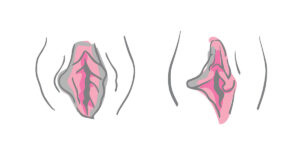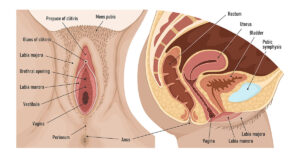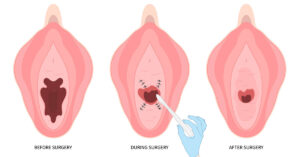Table of Contents:
- Addressing the Misconception: Is It Just Cosmetic?
- Does It Have Functional Benefits?
- What is Clitoral Hood Reduction?
- How It Differs from Clitoral Unhooding and Other Surgeries
- Who Can Consider This Procedure?
- Common Reasons Women Seek Clitoral Hood Reduction
- Functional Benefits: Beyond Aesthetics & Cosmetic Enhancements
- Myths & Misconceptions About Clitoral Hood Reduction
- Who is a Good Candidate for Clitoral Hood Reduction?
- Risks & Considerations: What Patients Should Know
- Clitoral Hood Reduction: More Than Just Aesthetic

Clitoral hood reduction is a minor surgical procedure designed to remove excess tissue surrounding the clitoris. This is often performed to enhance comfort, improve sensation, and create a more proportionate appearance. While commonly associated with cosmetic concerns, the procedure may also provide functional benefits for some women.
Addressing the Misconception: Is It Just Cosmetic?
Many assume that clitoral hood reduction is purely an aesthetic choice, similar to other forms of labiaplasty. However, for some women, excess tissue can cause physical discomfort, irritation during exercise, or reduced sensitivity during intimacy.
Does It Have Functional Benefits?
Beyond appearance, can this procedure improve sexual function or relieve discomfort? This article explores whether clitoral hood reduction offers more than just cosmetic enhancements.
For women seeking relief from discomfort or improved sexual well-being, understanding the potential functional benefits is crucial. Informed decisions can lead to greater confidence and quality of life.
What is Clitoral Hood Reduction?
Clitoral hood reduction is a surgical procedure designed to remove excess tissue from the clitoral prepuce (the skin that covers the clitoris). This excess tissue can sometimes obscure the clitoris, leading to discomfort, irritation, or decreased sexual sensitivity. During the procedure, a cosmetic gynecologist carefully trims the redundant tissue while preserving the delicate nerve structures, ensuring optimal function and sensitivity. The surgery is typically performed under local anesthesia and requires minimal recovery time.
How It Differs from Clitoral Unhooding and Other Surgeries
Clitoral hood reduction is often confused with clitoral unhooding, but the two procedures are distinct. Clitoral unhooding involves a more aggressive removal of tissue to fully expose the clitoris, whereas hood reduction focuses on enhancing comfort and proportion while maintaining natural coverage. It is also different from labiaplasty, which involves reshaping the labia minora or labia majora rather than the clitoral hood.
Who Can Consider This Procedure?
Women who experience chronic irritation, discomfort during intimacy, or dissatisfaction with the appearance of their genital area often consider clitoral hood reduction. Some seek the procedure for enhanced sensitivity, while others pursue it for improved hygiene or comfort in daily activities such as exercise or wearing tight clothing.
Common Reasons Women Seek Clitoral Hood Reduction
1. Aesthetic Concerns
For some women, the size or asymmetry of the clitoral hood can be a source of insecurity. Excess tissue may create an uneven appearance, leading to dissatisfaction with genital aesthetics. Clitoral hood reduction can provide a more proportionate look, which can contribute to greater body confidence and comfort.
2. Discomfort During Daily Activities
Excess clitoral hood tissue can cause irritation, chafing, or discomfort during activities such as cycling, running, or wearing tight clothing. Some women also experience discomfort or difficulty during sexual activity due to excessive tissue causing friction or interference with stimulation. Reduction surgery can help alleviate these issues, allowing for a more comfortable experience in both daily life and intimate moments.
3. Functional Benefits
In some cases, excess tissue can reduce clitoral sensitivity, making sexual pleasure more difficult to achieve. By trimming the extra skin, some women report enhanced responsiveness and stimulation, improving overall sexual satisfaction. Additionally, the procedure can relieve persistent irritation that results from moisture buildup and friction.
4. Psychological Factors
Beyond physical discomfort, the procedure can significantly impact self-esteem and confidence. Women who feel self-conscious about the appearance or function of their genital area may experience anxiety during intimacy. Clitoral hood reduction can provide peace of mind, leading to improved psychological well-being.
Functional Benefits: Beyond Aesthetics & Cosmetic Enhancements
While clitoral hood reduction is often viewed as a cosmetic procedure, many women choose it for functional reasons that improve their comfort, sexual well-being, and overall quality of life. Below are some key functional benefits of the surgery.
1. Enhanced Sexual Sensitivity
Excessive clitoral hood tissue can sometimes act as a barrier, reducing direct clitoral stimulation during sexual activity. This may make it more difficult to achieve orgasm or experience pleasurable sensations. By carefully reducing the excess tissue, some women report an increase in sensitivity, allowing for improved stimulation and a more fulfilling intimate experience.
However, it is important to acknowledge that results vary among individuals. Some women experience noticeable enhancements in sensation, while others may not see a significant change. The degree of sensitivity depends on nerve distribution, existing anatomy, and personal responsiveness to touch. Consulting a skilled surgeon ensures the procedure is tailored to the patient’s unique physiology.
2. Reduced Physical Discomfort
For many women, an enlarged clitoral hood can lead to irritation, chafing, or discomfort during everyday activities. Wearing tight clothing, engaging in physical exercise such as running or cycling, and even routine movements can become uncomfortable due to friction.
Women who undergo clitoral hood reduction often report increased comfort and relief from persistent irritation. Many testimonials highlight how the procedure allows them to wear fitted clothing, engage in sports, and enjoy intimacy without discomfort.
3. Improved Hygiene & Reduced Risk of Infections
Excess tissue in the clitoral hood can trap moisture, sweat, and bacteria, leading to an increased risk of irritation, yeast infections, and urinary tract infections (UTIs). This can be particularly problematic for women who experience frequent infections or struggle with maintaining hygiene due to excessive folds of skin.
By removing unnecessary tissue, airflow is improved, reducing the likelihood of bacterial buildup. Many women find that personal hygiene becomes easier and more effective, decreasing the risk of recurrent infections and discomfort.
4. Psychological & Emotional Well-Being
Feeling comfortable in one’s body has a profound impact on self-esteem and emotional well-being. Women who experience embarrassment or insecurity about their genital appearance may suffer from reduced confidence, anxiety during intimacy, or dissatisfaction with their body image.
By addressing functional concerns, clitoral hood reduction can provide a sense of relief and empowerment, allowing women to feel more confident in both personal and intimate settings. Additionally, an improved body image often correlates with enhanced sexual satisfaction, leading to a more positive overall experience in relationships.
Myths & Misconceptions About Clitoral Hood Reduction
Myth 1: It is only for cosmetic reasons.
While some women seek clitoral hood reduction for aesthetic reasons, many undergo the procedure to alleviate discomfort, irritation, or reduced sensitivity caused by excess tissue.
Myth 2: It will always increase sensitivity.
Although some women report enhanced sensation, results vary. The procedure removes excess skin but does not directly alter nerve function.
Myth 3: It is the same as female genital mutilation (FGM).
Unlike FGM, which is non-consensual and removes essential tissue, clitoral hood reduction is elective, safe, and medically supervised.
Myth 4: It is an unnecessary or risky procedure.
When performed by a qualified surgeon, the procedure is generally low-risk, with benefits for comfort, function, and confidence.
Who is a Good Candidate for Clitoral Hood Reduction?
Women considering clitoral hood reduction often seek the procedure for both functional and aesthetic reasons. Ideal candidates include:
1. Women experiencing physical discomfort or irritation
- Excess clitoral hood tissue can cause chafing, irritation, or pain during daily activities, exercise, or intimacy.
- Some may experience difficulty achieving sexual pleasure due to reduced clitoral stimulation.
2. Those seeking functional improvements beyond aesthetics:
- While some women pursue the procedure for cosmetic reasons, many choose it to enhance sensitivity, relieve irritation, and improve comfort.
- Improved genital symmetry and proportion can also contribute to better hygiene and reduced risk of infections.
Importance of a consultation with a board-certified cosmetic gynecologist
A thorough evaluation ensures the procedure is appropriate for the patient’s specific concerns. A specialist can discuss potential benefits, risks, and realistic expectations for the outcome.
Risks & Considerations: What Patients Should Know
While clitoral hood reduction is generally safe, it’s important to be aware of potential risks and necessary precautions:
Possible loss of sensation (though rare, it’s important to discuss):
- The procedure is designed to preserve nerve function and sexual sensation, but minor changes in sensitivity may occur.
- Most patients report either unchanged or improved sensitivity, but individual results vary.
Scarring, healing time, and post-operative care:
- Mild swelling, bruising, or discomfort is common in the first few weeks.
- Proper post-surgical care (keeping the area clean, avoiding friction) promotes healing and minimizes scarring.
- Full recovery typically takes 4-6 weeks, with results improving over time.
Importance of choosing a qualified, experienced surgeon:
- A board-certified specialist ensures precise technique, minimal risks, and optimal aesthetic and functional results.
- Proper surgical planning helps achieve natural-looking and comfortable outcomes tailored to the patient’s needs.
Clitoral Hood Reduction: More Than Just Aesthetic
While often considered a cosmetic procedure, clitoral hood reduction offers several functional benefits, including increased sexual sensitivity, reduced discomfort, improved hygiene, and enhanced emotional well-being. Women considering this surgery should consult a qualified, board-certified cosmetic gynecologist to determine whether it is the right option for their unique needs.
At our Labiaplasty NYC clinic, we specialize in clitoral hood reduction and other advanced vaginal rejuvenation procedures to help women achieve greater comfort, confidence, and overall well-being. Our expert team of board-certified cosmetic gynecologists provides personalized consultations to determine the best treatment options for your needs. Whether you’re looking to enhance sensitivity, relieve discomfort, or improve aesthetics, we offer safe and effective surgical solutions.
For more information or to schedule a consultation, contact us today and take the first step toward feeling your best.




